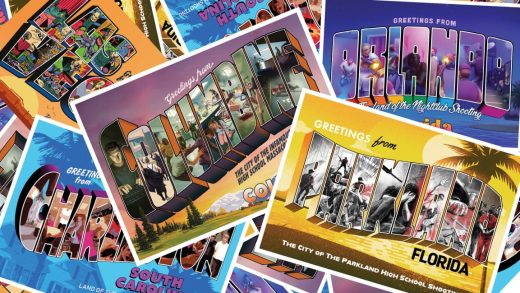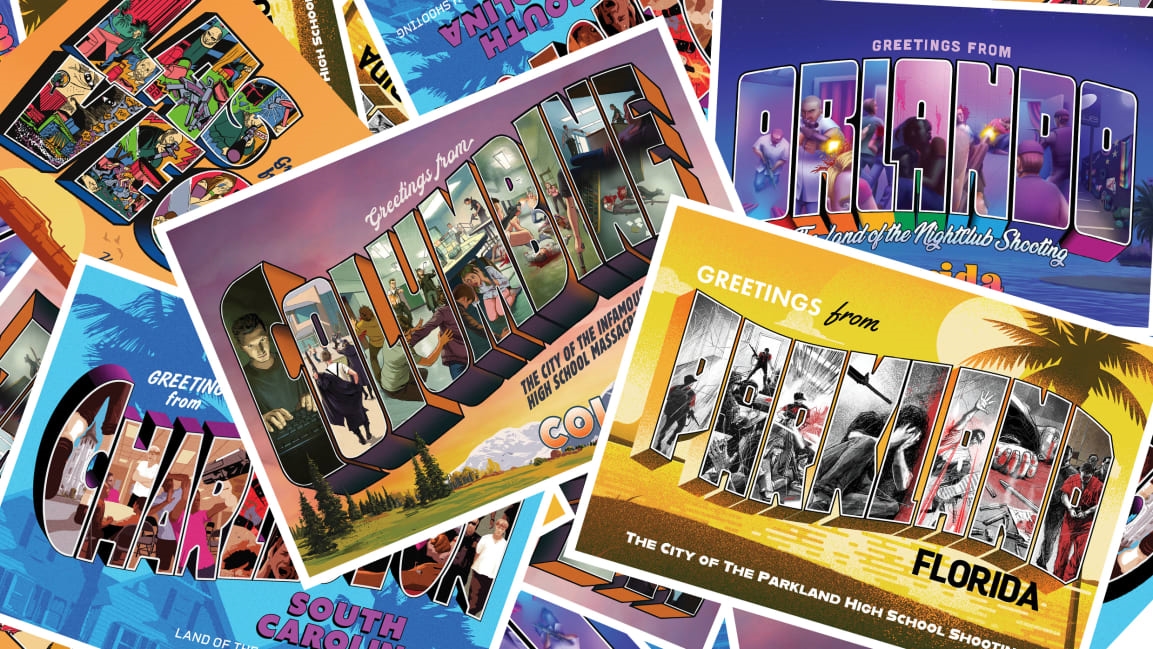These ‘Shamecards’ are frightening reminders of the legacies of mass shootings
That’s how those cities are reflected on the commonly found “Greetings From” postcards, which represent the locations and landmarks that vacation destinations strive to be known for. Those iconic postcards have been popular since they were first produced in the U.S. by German immigrant and publisher Curt Teich in 1931, and they continue to be known for their big-block text, inside which colorful drawings depict distinctive monuments and sites of interest.
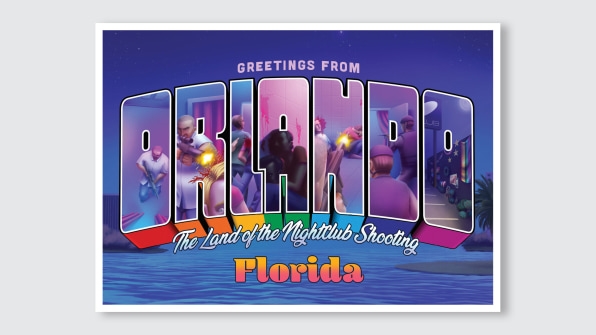
But instead of their landmarks, more and more American cities are becoming known for something far from enticing for travelers: mass shootings.
That hard truth has inspired a warped reimagining of the iconic postcards. A twisted parody, Shamecards is a new art activism project led by Manuel and Patricia Oliver, the parents of Joaquin Oliver, who was one of the 17 people who died in the shooting at Marjorie Stoneman Douglas High School in Parkland, Florida. “The campaign is covering, in a very cool, graphic way—in an Americana, vintage style—locations where mass shootings have become the center of attention,” Manuel says.
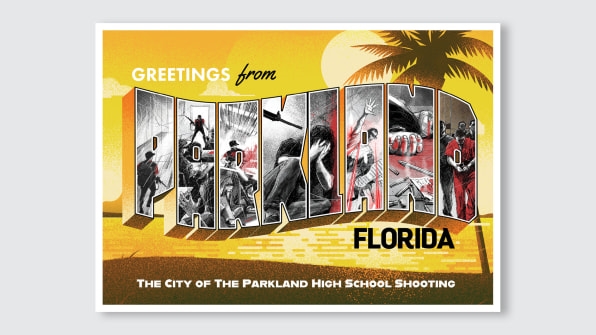
Within the large letters that spell out city names, these cards contain horrific and provocative imagery inspired by the now-infamous stories of mass shootings. Orlando’s contains images of a roaming shooter inside the Pulse Nightclub, with bloodstained walls and attendees cowering in corners. Charleston’s depicts the members of the Bible study in the Episcopal Church initially welcoming Dylann Roof; the scene turns to gunshots, visible screams, and bodies on the floor.
The text on the back also parodies the alluring copy traditionally found on such postcards. “Southern Florida is known for sand, surf, and the deadliest school shooting in United States history,” reads Parkland’s shamecard. Newtown’s is particularly jarring: “Connecticut is known for its peaceful bedroom communities, but on December 14, 2012, a 20-year-old man entered [Sandy Hook] elementary school and started shooting.” Inside the letters that spell Newtown, the images are flushed completely with a blood-red hue. Children’s lifeless hands dangle out of the letters.
There are 52 cards that portray shootings from Columbine to El Paso, and lesser-known incidents like in Roseburg, Oregon; Red Lake, Minnesota; and Honolulu, Hawaii. The message is the prevalence of gun violence. “It applies to almost every single city in America,” Manuel says.
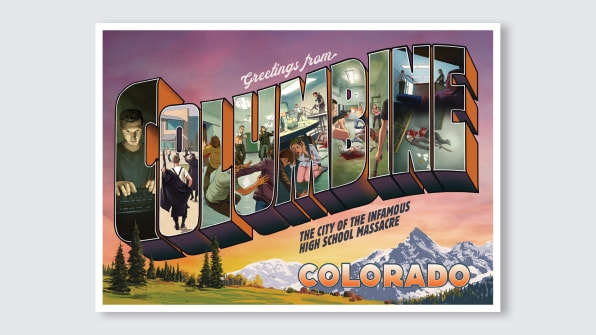
Advertising agency MullenLowe handled the evocative text, while 30 artists from 25 countries lent their visions to the artistic designs. It wasn’t a specific choice to recruit artists primarily outside the U.S., the couple says, but the uniquely American shame of gun violence is all the more astounding to outsiders. “They don’t get it,” Manuel says. “They don’t see how this could be an issue in a first-world nation.”
The Shamecards project was developed to raise awareness of gun violence and call people to action on gun reform. People can digitally send the postcards to congressional representatives in any state. Already, about 600 cards have been sent, even before the official launch day—Valentine’s Day, which marks the three-year anniversary of Parkland. A twelve-by-eight-foot mural of the Parkland Shamecard will be on display in that community. Selected cities will also have pop-up Shamecard stalls, where passers-by can pick up hard copies and flood congressional inboxes.
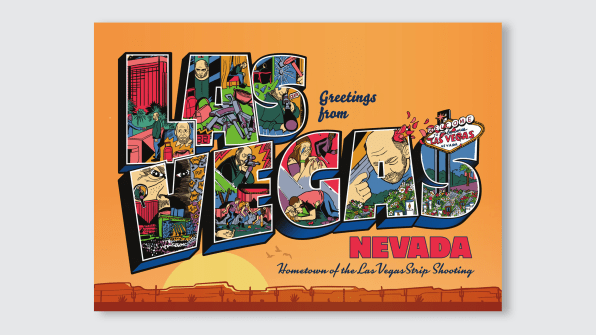
Since Parkland, the rate of gun deaths has continued to increase (and it even increased in 2020, despite pandemic lockdowns), yet nothing has been done to fix lax gun laws on a federal level. The Olivers created a nonprofit, Change the Ref, to help end this inaction on gun reform through art activism. “I’m glad that we found this as the way to keep on moving on with our lives,” Manuel says. The group has curated art exhibitions, commissioned murals, and even organized a live-show tour dedicated to their son, called Guac: My Son, My Hero. “The inspiration for everything that we do is our son, Joaquin,” Manuel says, “in addition to any victim of gun violence from any corner in the nation.”
In the emotional aftermath of each mass shooting, a now-familiar debate invariably arises over minimizing discussion about the shooter, so as not to create a cult figure for copycats. Many of the Shamecards feature the killer quite prominently. Some also use a cartoonish, action-comic style that could appear to be glamorizing violence. But Manuel argues that the shooters should be depicted, because they are the central part of the dreadful horror of the scenes. Erasing the killer could allow people to forget the heinous acts they committed. “I don’t feel offended by placing the criminals’ faces on the Shamecards,” he says. “I’m offended that my son was shot four times and murdered for no reason.”
Heightening the shock value is simply another way to try to get people to understand the gravity of the issue. “I have tried multiple ways to impact American society and to warn them about gun violence,” Manuel says. “Maybe this time, society will get the point.” They hope the project will help keep gun violence on people’s minds, as it consistently slips from national attention after each shooting. They do expect the new Democratic administration, which has promised action on gun reform, to step up—and they think lawmakers might have extra cause to empathize with the victims of school shootings after many fearfully hid from potentially armed rioters in the Capitol on January 6.
Still, governmental inaction has been the status quo on this issue for decades, Patricia says. That’s what the Shamecards are for: “We are here to be the reminders.”
(20)

